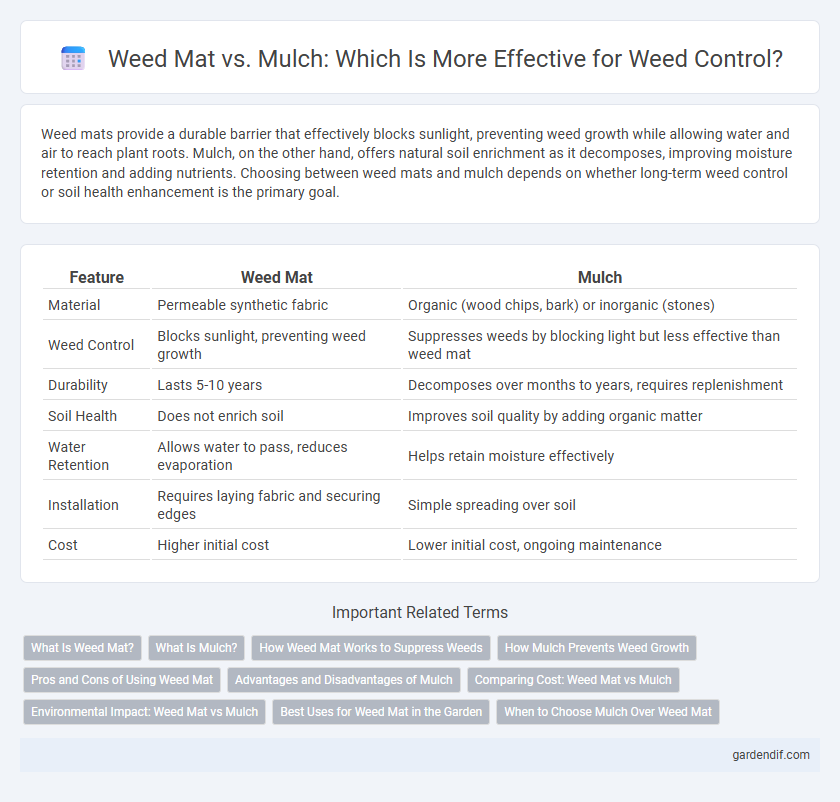
Weed mat vs mulch Illustration
Weed mats provide a durable barrier that effectively blocks sunlight, preventing weed growth while allowing water and air to reach plant roots. Mulch, on the other hand, offers natural soil enrichment as it decomposes, improving moisture retention and adding nutrients. Choosing between weed mats and mulch depends on whether long-term weed control or soil health enhancement is the primary goal.
Table of Comparison
| Feature | Weed Mat | Mulch |
|---|---|---|
| Material | Permeable synthetic fabric | Organic (wood chips, bark) or inorganic (stones) |
| Weed Control | Blocks sunlight, preventing weed growth | Suppresses weeds by blocking light but less effective than weed mat |
| Durability | Lasts 5-10 years | Decomposes over months to years, requires replenishment |
| Soil Health | Does not enrich soil | Improves soil quality by adding organic matter |
| Water Retention | Allows water to pass, reduces evaporation | Helps retain moisture effectively |
| Installation | Requires laying fabric and securing edges | Simple spreading over soil |
| Cost | Higher initial cost | Lower initial cost, ongoing maintenance |
What Is Weed Mat?
Weed mat is a durable, woven fabric designed to suppress weed growth by blocking sunlight while allowing water and air to pass through, promoting healthy soil conditions. Unlike traditional mulch, weed mats provide a long-lasting barrier that reduces the need for frequent replacement and maintenance. Commonly made from polypropylene or polyester, these mats are used in gardens and landscaping to enhance weed control efficiently.
What Is Mulch?
Mulch is a protective layer of organic or inorganic material spread over soil to retain moisture, suppress weeds, and regulate soil temperature. Common types of mulch include wood chips, straw, and compost, which gradually decompose and enrich the soil with nutrients. Effective mulch application reduces the need for herbicides and promotes healthier plant growth by improving soil structure.
How Weed Mat Works to Suppress Weeds
Weed mat functions by creating a physical barrier that blocks sunlight, preventing weed seeds from germinating and growing. The breathable fabric allows water and nutrients to reach the soil while restricting weed growth beneath the surface. This results in effective weed suppression, reducing the need for chemical herbicides and manual weeding.
How Mulch Prevents Weed Growth
Mulch prevents weed growth by blocking sunlight, which inhibits the germination and photosynthesis of weed seeds. Its thick layer acts as a physical barrier, reducing the chance for weed seeds to reach the soil and sprout. Organic mulches also improve soil moisture retention and temperature regulation, creating an environment less favorable to invasive weed species.
Pros and Cons of Using Weed Mat
Weed mats offer effective soil protection by blocking sunlight, which suppresses weed growth and reduces the need for chemical herbicides, making them environmentally friendly. They allow water and air permeability, promoting healthy root development, but can be costly and may degrade over time, requiring replacement. Weed mats can limit organic matter absorption compared to mulch, potentially impacting soil fertility and microbial activity.
Advantages and Disadvantages of Mulch
Mulch effectively suppresses weed growth by blocking sunlight and retaining soil moisture, promoting healthier plants and reducing water evaporation. It improves soil fertility as organic mulch decomposes, enriching the soil with nutrients, though inorganic mulch lacks this benefit. However, mulch can attract pests and may require regular replenishment, while heavy layers risk suffocating plant roots or causing fungal growth.
Comparing Cost: Weed Mat vs Mulch
Weed mats typically cost between $0.10 to $0.50 per square foot, offering long-term durability that reduces the need for frequent replacement compared to mulch, which usually costs $0.30 to $2.00 per square foot depending on the type and quality. While initial expenses for weed mats are often higher, mulch requires regular replenishing, making its cumulative cost over time potentially greater. Considering maintenance frequency and lifespan, weed mats provide a cost-effective solution for persistent weed control in landscaping projects.
Environmental Impact: Weed Mat vs Mulch
Weed mats offer a durable, reusable barrier that reduces soil erosion and minimizes water runoff, contributing to better environmental sustainability compared to single-use mulches. Organic mulches decompose over time, enriching soil fertility and promoting beneficial microbial activity, but require frequent replacement, which can increase waste. Choosing between weed mats and mulch hinges on balancing long-term environmental benefits from reduced waste against natural soil enhancement through organic matter.
Best Uses for Weed Mat in the Garden
Weed mats are best used in vegetable beds, flower borders, and under pathways to effectively block sunlight and prevent weed growth while allowing water and air to reach plant roots. Their durability and permeability make them ideal for long-term weed control in high-traffic garden areas without the need for frequent replacement. Compared to mulch, weed mats provide a more consistent barrier against weeds and reduce soil erosion, supporting healthier plant development.
When to Choose Mulch Over Weed Mat
Choose mulch over weed mat when soil moisture retention and organic matter enrichment are priorities, as mulch decomposes to enhance soil fertility. Mulch is ideal in garden beds with irregular plant spacing or delicate root systems, where weed mats may restrict growth or water infiltration. For areas requiring easy seasonal planting changes, mulch offers flexibility compared to the long-term barrier created by weed mats.
Weed mat vs mulch Infographic

 gardendif.com
gardendif.com